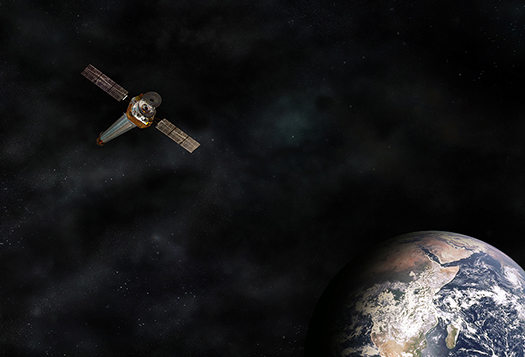For Release: Oct. 24, 2018
NASA/CXC

On the evening of October 21, Chandra returned to science observations after the team successfully carried out a procedure to enable a new gyroscope configuration for the spacecraft. The team initiated a set of maneuvers to change the pointing and orientation of the spacecraft to confirm that the gyroscopes were behaving as expected. During the coming week, scientists will collect spacecraft data to fine-tune the performance for the new gyroscope configuration. As a final step, the team will uplink a software patch to apply any necessary adjustments to the on-board computer.
Previous update (posted October 19, 2018)
Chandra remains in its normal pointing mode and has been maneuvered to ensure the spacecraft and instruments remain at a cool operating temperature. The Flight Operations Team has completed testing and simulation of the procedures and on-board software updates that will place Chandra into a new gyroscope configuration with the gyroscope that caused the October 10 safe mode in reserve. The switch is scheduled for Friday night and will be followed by a period of collecting maneuver data to validate and calibrate the new configuration prior to resuming science observing, planned for early next week.
Previous update (posted October 15, 2018)
The cause of Chandra's safe mode on October 10 has now been understood and the Operations team has successfully returned the spacecraft to its normal pointing mode. The safe mode was caused by a glitch in one of Chandra's gyroscopes resulting in a 3-second period of bad data that in turn led the on-board computer to calculate an incorrect value for the spacecraft momentum. The erroneous momentum indication then triggered the safe mode.
The team has completed plans to switch gyroscopes and place the gyroscope that experienced the glitch in reserve. Once configured with a series of pre-tested flight software patches, the team will return Chandra to science operations which are expected to commence by the end of this week.
Previous update (posted October 12, 2018)
At approximately 9:55 a.m. EDT on Oct. 10, 2018, NASA's Chandra X-ray Observatory entered safe mode, in which the observatory is put into a safe configuration, critical hardware is swapped to back-up units, the spacecraft points so that the solar panels get maximum sunlight, and the mirrors point away from the Sun. Analysis of available data indicates the transition to safe mode was normal behavior for such an event. All systems functioned as expected and the scientific instruments are safe. The cause of the safe mode transition (possibly involving a gyroscope) is under investigation, and we will post more information when it becomes available.
Chandra is 19 years old, which is well beyond the original design lifetime of 5 years. In 2001, NASA extended its lifetime to 10 years. It is now well into its extended mission and is expected to continue carrying out forefront science for many years to come.
For information about NASA and other agency programs, visit:
-end-
Media Contacts:
Felicia Chou
NASA Headquarters, Washington
202-358-0257
felicia.chou@nasa.gov
Molly Porter
Marshall Space Flight Center, Huntsville, Alabama
256-544-0034
molly.a.porter@nasa.gov
Megan Watzke
Chandra X-ray Center, Cambridge, Massachusetts
617-496-7998
mwatzke@cfa.harvard.edu


